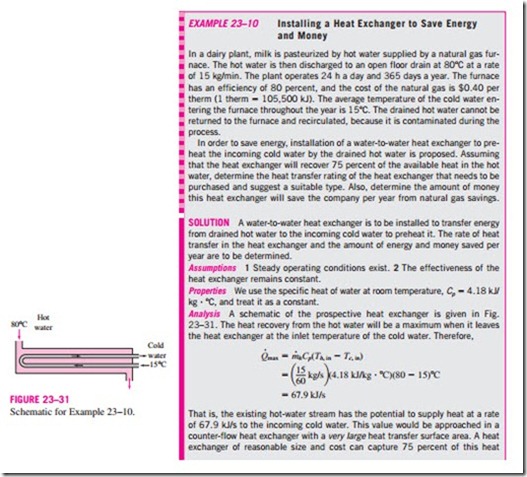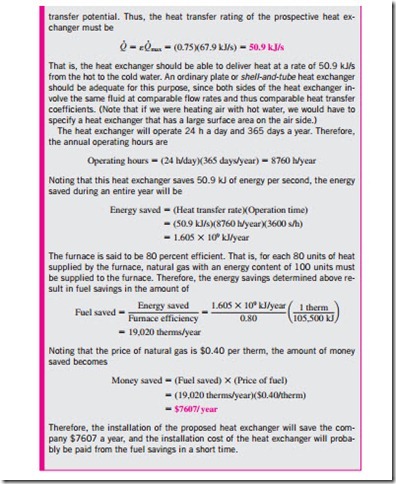SELECTION OF HEAT EXCHANGERS
Heat exchangers are complicated devices, and the results obtained with the simplified approaches presented above should be used with care. For example, we assumed that the overall heat transfer coefficient U is constant throughout the heat exchanger and that the convection heat transfer coefficients can be predicted using the convection correlations. However, it should be kept in mind that the uncertainty in the predicted value of U can even exceed 30 per- cent. Thus, it is natural to tend to overdesign the heat exchangers in order to avoid unpleasant surprises.
Heat transfer enhancement in heat exchangers is usually accompanied by increased pressure drop, and thus higher pumping power. Therefore, any gain from the enhancement in heat transfer should be weighed against the cost of the accompanying pressure drop. Also, some thought should be given to which fluid should pass through the tube side and which through the shell side. Usually, the more viscous fluid is more suitable for the shell side (larger passage area and thus lower pressure drop) and the fluid with the higher pres- sure for the tube side.
Engineers in industry often find themselves in a position to select heat exchangers to accomplish certain heat transfer tasks. Usually, the goal is to heat or cool a certain fluid at a known mass flow rate and temperature to a desired temperature. Thus, the rate of heat transfer in the prospective heat exchanger is
which gives the heat transfer requirement of the heat exchanger before having any idea about the heat exchanger itself.
An engineer going through catalogs of heat exchanger manufacturers will be overwhelmed by the type and number of readily available off-the-shelf heat exchangers. The proper selection depends on several factors.
Heat Transfer Rate
This is the most important quantity in the selection of a heat exchanger. A heat
exchanger should be capable of transferring heat at the specified rate in order to achieve the desired temperature change of the fluid at the specified mass flow rate.
Cost
Budgetary limitations usually play an important role in the selection of heat exchangers, except for some specialized cases where “money is no object.” An off-the-shelf heat exchanger has a definite cost advantage over those made to order. However, in some cases, none of the existing heat exchangers will do, and it may be necessary to undertake the expensive and time-consuming task of designing and manufacturing a heat exchanger from scratch to suit the needs. This is often the case when the heat exchanger is an integral part of the overall device to be manufactured.
The operation and maintenance costs of the heat exchanger are also important considerations in assessing the overall cost.
Pumping Power
In a heat exchanger, both fluids are usually forced to flow by pumps or fans that consume electrical power. The annual cost of electricity associated with the operation of the pumps and fans can be determined from
where the pumping power is the total electrical power consumed by the motors of the pumps and fans. For example, a heat exchanger that involves a 1-hp pump and a 1 -hp fan (1 hp = 0.746 kW) operating 8 h a day and 5 days a week will consume 2017 kWh of electricity per year, which will cost $161.4 at an electricity cost of 8 cents/kWh.
Minimizing the pressure drop and the mass flow rate of the fluids will minimize the operating cost of the heat exchanger, but it will maximize the size of the heat exchanger and thus the initial cost. As a rule of thumb, doubling the mass flow rate will reduce the initial cost by half but will increase the pumping power requirements by a factor of roughly eight.
Typically, fluid velocities encountered in heat exchangers range between 0.7 and 7 m/s for liquids and between 3 and 30 m/s for gases. Low velocities are helpful in avoiding erosion, tube vibrations, and noise as well as pres- sure drop.
Size and Weight
Normally, the smaller and the lighter the heat exchanger, the better it is. This is especially the case in the automotive and aerospace industries, where size and weight requirements are most stringent. Also, a larger heat exchanger normally carries a higher price tag. The space available for the heat exchanger in some cases limits the length of the tubes that can be used.
Type
The type of heat exchanger to be selected depends primarily on the type of
fluids involved, the size and weight limitations, and the presence of any phase- change processes. For example, a heat exchanger is suitable to cool a liquid by a gas if the surface area on the gas side is many times that on the liquid side. On the other hand, a plate or shell-and-tube heat exchanger is very suit- able for cooling a liquid by another liquid.
Materials
The materials used in the construction of the heat exchanger may be an important consideration in the selection of heat exchangers. For example, the thermal and structural stress effects need not be considered at pressures below 15 atm or temperatures below 150°C. But these effects are major considerations above 70 atm or 550°C and seriously limit the acceptable materials of the heat exchanger.
![]() A temperature difference of 50°C or more between the tubes and the shell will probably pose differential thermal expansion problems and needs to be considered. In the case of corrosive fluids, we may have to select expensive corrosion-resistant materials such as stainless steel or even titanium if we are not willing to replace low-cost heat exchangers frequently.
A temperature difference of 50°C or more between the tubes and the shell will probably pose differential thermal expansion problems and needs to be considered. In the case of corrosive fluids, we may have to select expensive corrosion-resistant materials such as stainless steel or even titanium if we are not willing to replace low-cost heat exchangers frequently.
Other Considerations
There are other considerations in the selection of heat exchangers that may or may not be important, depending on the application. For example, being leak-tight is an important consideration when toxic or expensive fluids are involved. Ease of servicing, low maintenance cost, and safety and reliability are some other important considerations in the selection process. Quietness is one of the primary considerations in the selection of liquid-to-air heat exchangers used in heating and air-conditioning applications.

